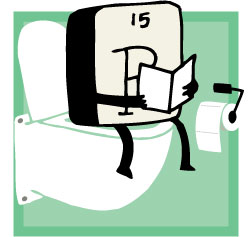Blogging the Periodic Table

A diet that lacks even obscure elements like selenium will leave almost any creature on earth sick and hobbled, if not dead. Plants are made of the same basic stuff as animals but have different nutritional needs and need their elements, like nitrogen, in different forms. In fact, the amount of Element 7 available in the soil severely restricts how many plants can grow there. Carnivorous plants, like Venus flytraps, consume bugs mostly to get at their nitrogen.
Fertilizers make plants grow by delivering nitrogen (and other elements, like phosphorus) in high-octane forms. Early farmers fertilized crops with urine or dung, usually scraped from "stables, sheep pens, pigeon houses, caverns, and even peasants' cottages—any place manure and refuse accumulated," as one historian reports. After the Industrial Revolution, the demands of agriculture became too onerous for sheep, pigeons, and peasants to keep up, so European countries began to mine nitrogen fertilizers in South America, especially from deposits of Chile saltpeter. (It was known as Peru saltpeter until Chile wrestled the mines away from Peru in the "Saltpeter War" in the 1880s.) But already by 1900, Chile had depleted its saltpeter stores, and a worldwide food crisis seemed imminent.
Now, some of you who remember your periodic table might have noticed something funny about these claims of scarcity. After all, one fundamental law of matter says you can't "use up" elements like nitrogen—they're conserved, neither created nor destroyed. So an atom of nitrogen can never really disappear. (Radioactive elements do decay and disappear, but the vast majority of atoms are not radioactive.) Besides, there's plenty of nitrogen in the air—four out of every five molecules you breathe. It's hardly in short supply.
That said, the useful form of an element can disappear. Pure nitrogen in the air acts differently than saltpeter nitrogen, which is locked into a molecule called a nitrate. For plants, nitrogen in the air just isn't palatable—it's analogous to dying of thirst in the middle of the ocean. Plants need nitrates or other forms of the element. So even though the world supply of nitrogen atoms hadn't decreased by 1900, the supply of nitrogen that plants can actually use had decreased.
Thankfully, a few years later a German chemist with a pince-nez named Fritz Haber devised a way to derive ammonia (NH3) from nitrogen. Because ammonia converts readily into fertilizer, Haber probably helped avert worldwide famine. (Haber is among the most interesting and disgusting figures in science history, both a Nobel Prize winner for his nitrogen work and an international war criminal for his role in "perfecting" gas warfare during World War I.)
But history repeats itself in scary ways, and some agricultural scientists today fret that we're eating our way into another fertilizer shortage—and with an element we can't conjure out of thin air, phosphorus. They call the threat "peak phosphorus," or for the initiated, peak P. (It's a play on "peak oil," the idea that we've already burned up half or more of the world's oil supply and that we'll use up the remainder frighteningly quickly.)
Plants need phosphorus in a form called phosphate, familiar to many of us from cherry or lime phosphates in old-fashioned soda shops. Living creatures use phosphates as the structural girder for DNA, and also in a molecule called ATP that provides the power to run cells. Human beings are 1 percent phosphorus by weight, and scientists have long known how important an element it is for health. Even with all the other problems of the Great Depression going on, FDR gave a speech warning America about the diminishing phosphorus in our food. Ninety percent of the phosphorus mined today (it's abundant in China, Morocco, Idaho, and Florida) ends up in fertilizer bags.
Unfortunately, erosion and runoff waste half of that phosphorus, as the phosphates end up scattered deep underground or chemically changed. So even though the phosphorus atoms never disappear, they're not available as fertilizer. The world has between 4 billion and 8 billion tons of phosphate reserves, and we extract one-eighth of a billion tons per year. So simple arithmetic says we could "run out" of phosphorus in about 30 years. The end could come even sooner if we ramp up biofuel production, since switchgrass, corn, and other biofuel crops will require loads of phosphorus-rich fertilizer. And unlike nitrogen, there's no other ready source than mining.
What can we do? There's scrimping, of course, but humans almost never do that well, (See peak oil.) We prefer technical solutions. One promising strategy calls for recycling P. And the easiest way to do so is to recycle pee—through a European technology called NoMix toilets, which have separate basins in the porcelain bowl for different kinds of waste. Feces contains some phosphorus, but urine is brimming with the stuff, and it's much easier to recapture phosphorus from urine before it gets mixed in with sewage sludge. The great advantage of NoMix toilets is that they're passive—people install them once, and pipes do the rest.
The disadvantages? Most people don't want funny-looking toilets. As a recent scholarly paper puts it, "NoMix technology has a sensitive end-point: people's bathrooms." And, um, males might have to sit down to pee. (The toilet's urine-collection basin, high up near the rim of the toilet and very close to the front edge, makes it hard to avoid making a mess otherwise.) That same scholarly paper noted that 80 percent of Europeans, male and otherwise, had positive feelings about NoMix toilets. It's harder to imagine real American men being equally enthusiastic. Europeans already have a reputation as pantywaists in some red-meat circles, especially in agricultural states. If NoMix technology becomes fashionable, it's easy to imagine the toilets being derided as further proof of the degeneracy and basic wimpiness of Europeans. Then again, those farmers from ag states might need that phosphorus badly enough in 30 years that sitting down for a few seconds could be worth it.
Like Slate on Facebook. Follow us on Twitter.